|
THE COMMON FROG
CHAPTER I.
The Common Frog | ||
1.
THE COMMON FROG
CHAPTER I.
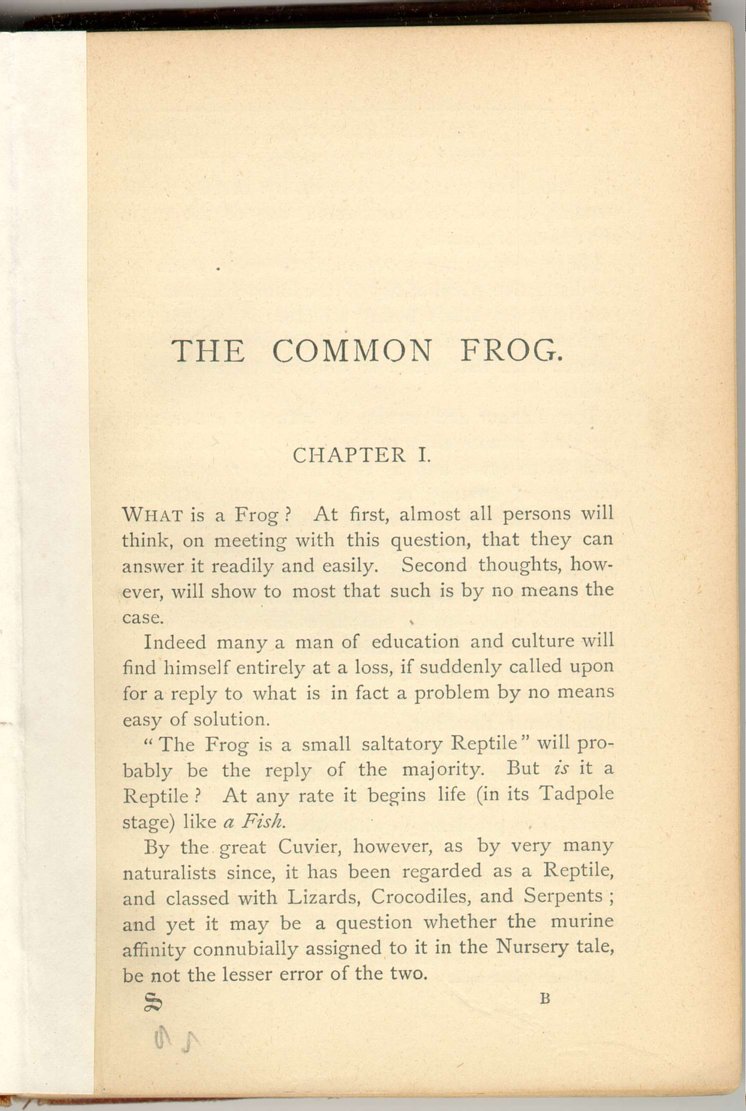 [Description:
Image of page 1.
]
[Description:
Image of page 1.
]
What is a Frog? At first, almost
all persons will think, on meeting with this question, that
they can answer it readily and easily. Second thoughts, however,
will show to most that such is by no means the case.
Indeed many a man of education and culture will find himself entirely at a loss, if suddenly called upon for a reply to what is in fact a problem by no means easy of solution.
"The Frog is a small saltatory Reptile" will probably be the reply of the majority. But is it a Reptile? At any rate it begins life (in its Tadpole stage) like a Fish.
By the great Cuvier, however, as by very many naturalists since, it has been regarded as a Reptile, and classed with Lizards, Crocodiles, and Serpents; and yet it may be a question whether the murine affinity connubially assigned to it in the Nursery tale, be not the lesser error of the two.
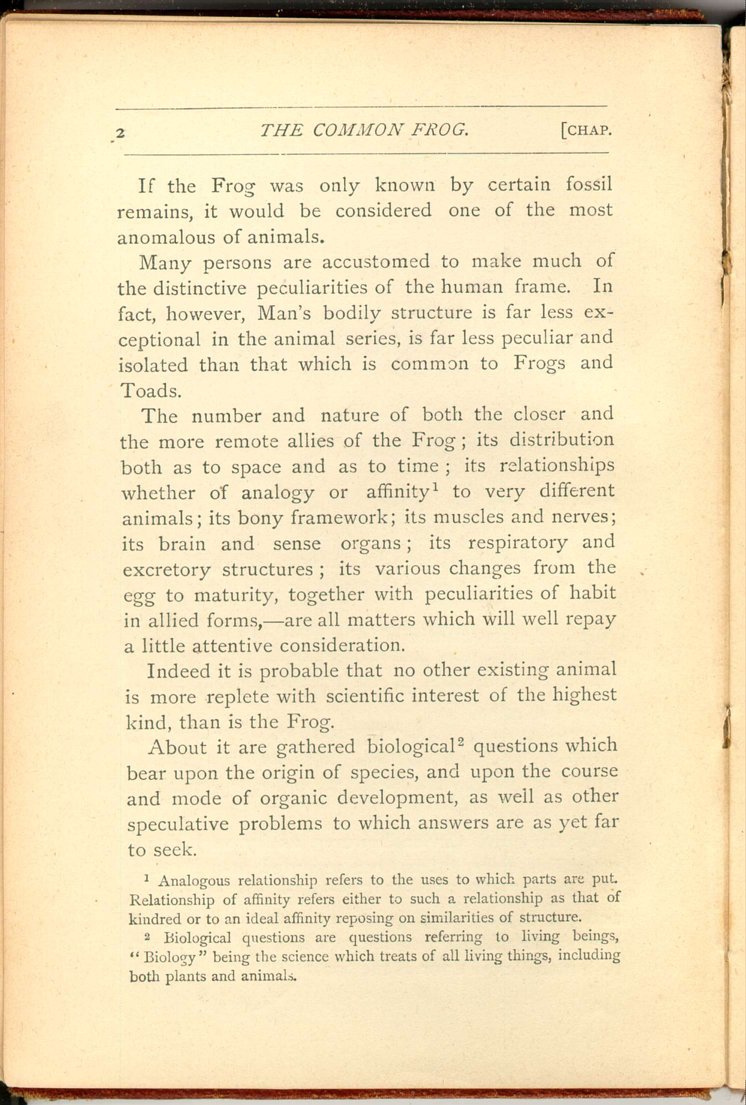 [Description:
Image of page 2.
]
[Description:
Image of page 2.
]
If the Frog was only known by certain fossil remains, it would be considered one of the most anomalous of animals.
Many persons are accustomed to make much of the distinctive peculiarities of the human frame. In fact, however, Man's bodily structure is far less exceptional in the animal series, is far less peculiar and isolated than that which is common to Frogs and Toads.
The number and nature of both the closer and the more remote allies of the Frog; its distribution both as to space and as to time; its relationships whether of analogy or affinity [1]to very different animals; its bony framework; its muscles and nerves; its brain and sense organs; its respiratory and excretory structures; its various changes from the egg to maturity, together with peculiarities of habit in allied forms, — are all matters which will well repay a little attentive consideration.
Indeed it is probable that no other existing animal is more replete with scientific interest of the highest kind, than is the Frog.
About it are gathered biological [2] questions which bear upon the origin of species, and upon the course and mode of organic development, as well as other speculative problems to which answers are as yet far to seek.
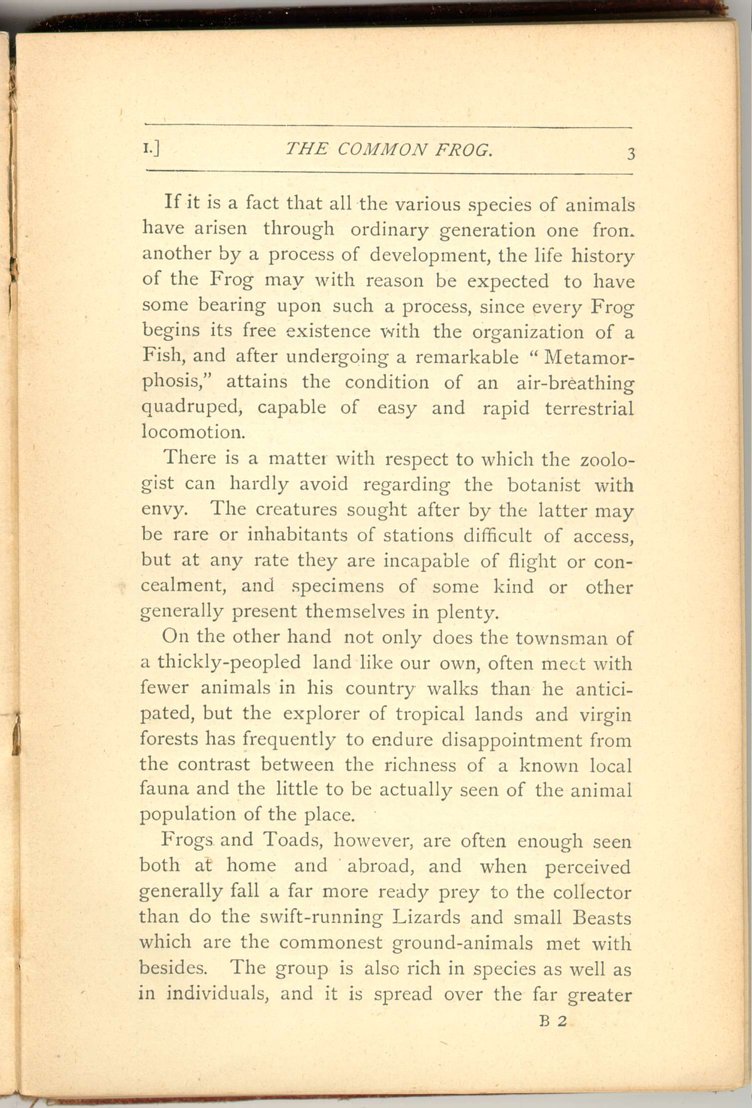 [Description:
Image of page 3.
]
[Description:
Image of page 3.
]
If it is a fact that all the various species of animals have arisen through ordinary generation one from another by a process of development, the life history of the Frog may with reason be expected to have some bearing upon such a process, since every Frog begins its free existence with the organization of a Fish, and after undergoing a remarkable Metamorphosis, attains the condition of an air-breathing quadruped, capable of easy and rapid terrestrial locomotion.
There is a matter with respect to which the zoologist can hardly avoid regarding the botanist with envy. The creatures sought after by the latter may be rare or inhabitants of stations difficult of access, but at any rate they are incapable of flight or concealment, and specimens of some kind or other generally present themselves in plenty.
On the other hand not only does the townsman of a thickly-peopled land like our own, often meet with fewer animals in his country walks than he anticipated, but the explorer of tropical lands and virgin forests has frequently to endure disappointment from the contrast between the richness of a known local fauna and the little to be actually seen of the animal population of the place.
Frogs and Toads, however, are often enough seen both at home and abroad, and when perceived generally fall a far more ready prey to the collector than do the swift-running Lizards and small Beasts which are the commonest ground-animals met with besides. The group is also rich in species as well as in individuals, and it is spread over the far greater
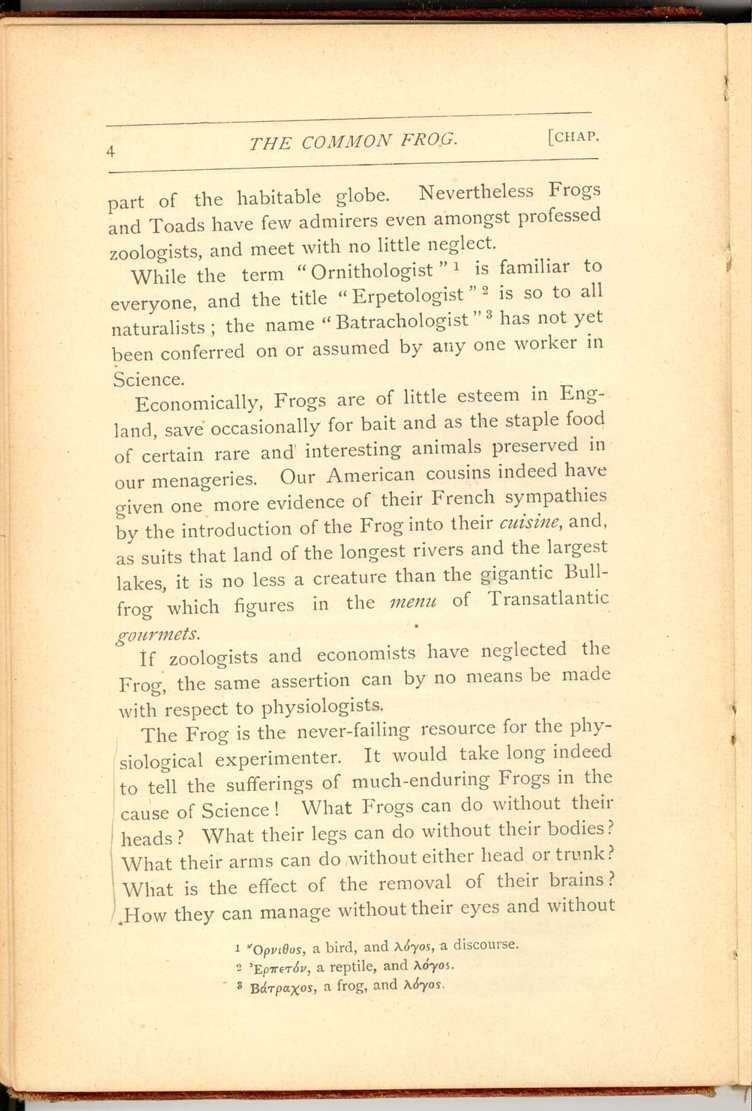 [Description:
Image of page 4.
]
[Description:
Image of page 4.
]
While the term "Ornithologist" [3] is familiar to everyone, and the title "Erpetologist" [4] is so to all naturalists; the name "Batrachologist" [5] has not yet been conferred on or assumed by any one worker in Science.
Economically, Frogs are of little esteem in England, save occasionally for bait and as the staple food of certain rare and interesting animals preserved in our menageries. Our American cousins indeed have given one more evidence of their French sympathies by the introduction of the Frog into their cuisine, and, as suits that land of the longest rivers and the largest lakes, it is no less a creature than the gigantic Bull frog which figures in the menu of Transatlantic gourmets.
If zoologists and economists have neglected the Frog, the same assertion can by no means be made with respect to physiologists.
The Frog is the never-failing resource for the physiological experimenter. It would take long indeed to tell the sufferings of much-enduring Frogs in the cause of Science! What Frogs can do without their heads? What their legs can do without their bodies? What their arms can do without either head or trunk? What is the effect of the removal of their brains? How they can manage without their eyes and without
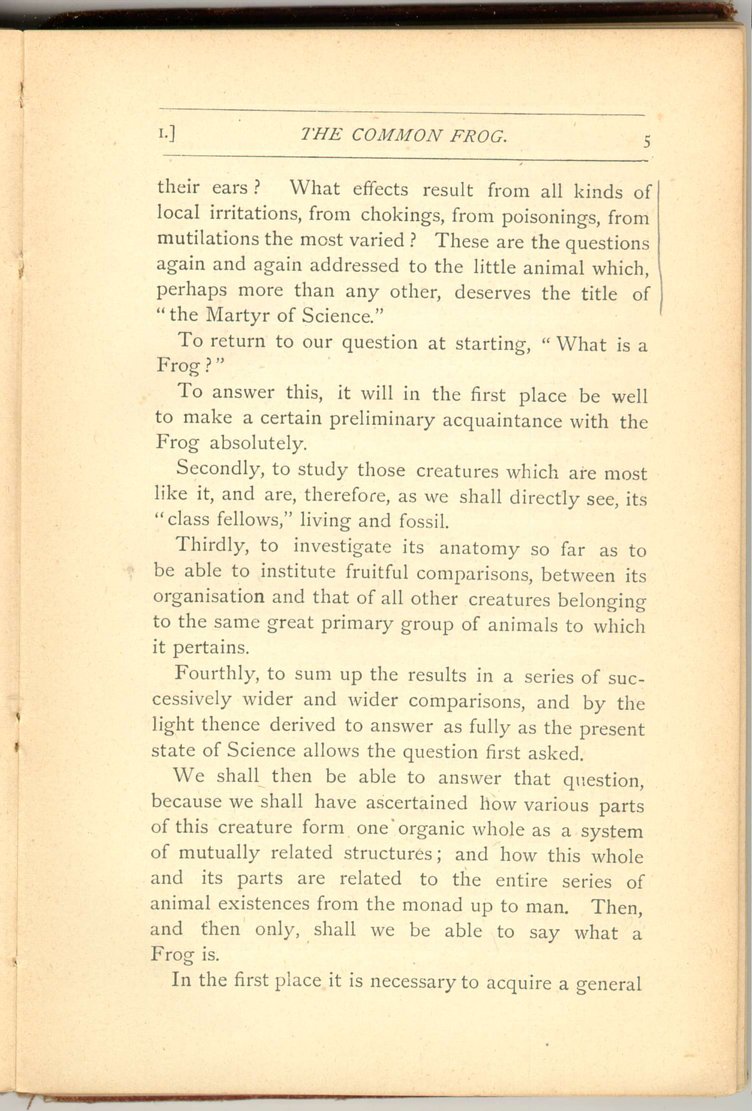 [Description:
Image of page 5.
]
[Description:
Image of page 5.
]
To return to our question at starting, "What is a Frog?"
To answer this, it will in the first place be well to make a certain preliminary acquaintance with the Frog absolutely.
Secondly, to study those creatures which are most like it, and are, therefore, as we shall directly see, its "class fellows," living and fossil.
Thirdly, to investigate its anatomy so far as to be able to institute fruitful comparisons, between its organisation and that of all other creatures belonging to the same great primary group of animals to which it pertains.
Fourthly, to sum up the results in a series of successively wider and wider comparisons, and by the light thence derived to answer as fully as the present state of Science allows the question first asked.
We shall then be able to answer that question, because we shall have ascertained how various parts of this creature form one organic whole as a system of mutually related structures; and how this whole and its parts are related to the entire series of animal existences from the monad up to man. Then, and then only, shall we be able to say what a Frog is.
In the first place it is necessary to acquire a general
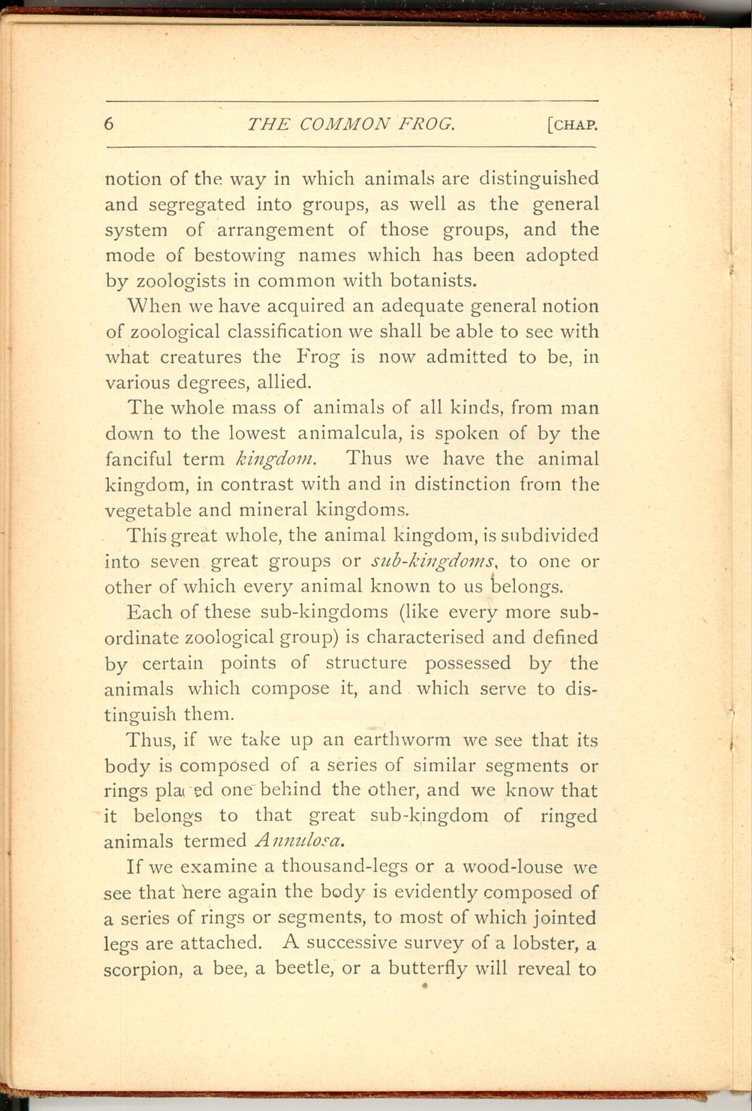 [Description:
Image of page 6.
]
[Description:
Image of page 6.
]
When we have acquired an adequate general notion of zoological classification we shall be able to see with what creatures the Frog is now admitted to be, invarious degrees, allied.
The whole mass of animals of all kinds, from man down to the lowest animalcula, is spoken of by the fanciful term kingdom. Thus we have the animal kingdom, in contrast with and in distinction from the vegetable and mineral kingdoms.
This great whole, the animal kingdom, is subdivided into seven great groups or sub-kingdoms, to one or other of which every animal known to us belongs.
Each of these sub-kingdoms (like every more subordinate zoological group) is characterised and defined by certain points of structure possessed by the animals which compose it, and which serve to distinguish them.
Thus, if we take up an earthworm we see that its body is composed of a series of similar segments or rings placed one behind the other, and we know that it belongs to that great sub-kingdom of ringed animals termed Annulosa.
If we examine a thousand-legs or a wood-louse we see that here again the body is evidently composed of a series of rings or segments, to most of which jointed legs are attached. A successive survey of a lobster, a scorpion, a bee, a beetle, or a butterfly will reveal to
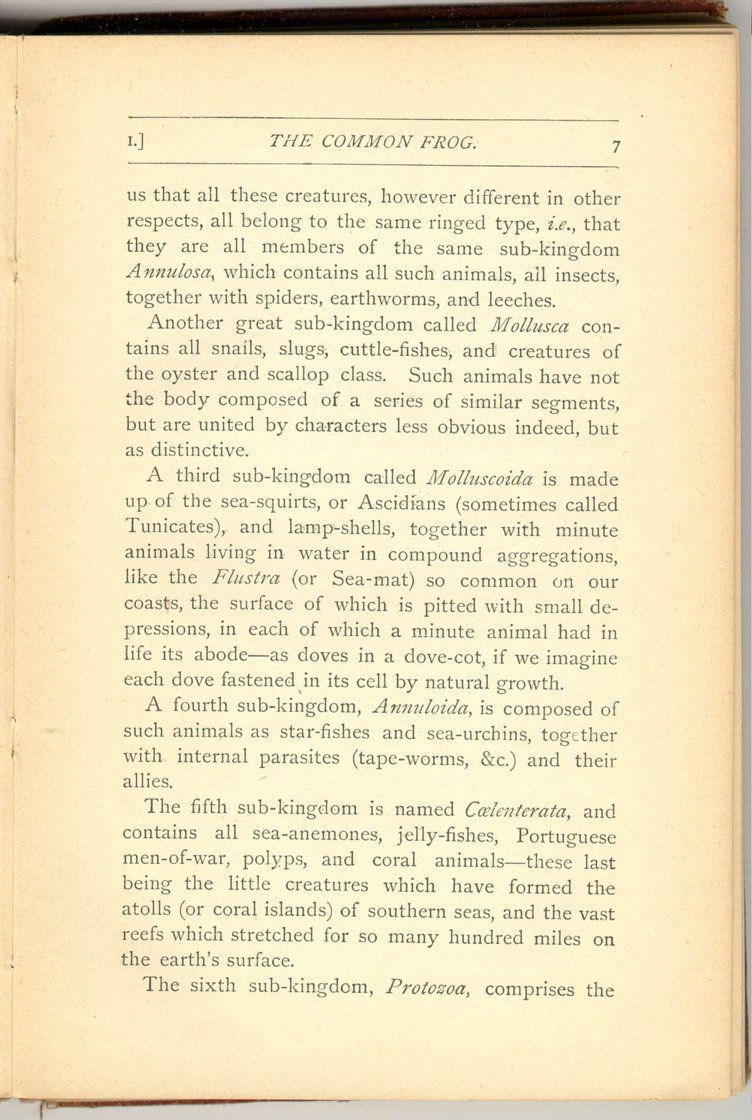 [Description:
Image of page 7.
]
[Description:
Image of page 7.
]
Another great sub-kingdom called Mollusca contains all snails, slugs, cuttle-fishes, and creatures of the oyster and scallop class. Such animals have not the body composed of a series of similar segments, but are united by characters less obvious indeed, but as distinctive.
A third sub-kingdom called Molluscoida is made up of the sea-squirts, or Ascidians (sometimes called Tunicates), and lamp-shells, together with minute animals living in water in compound aggregations, like the Flustra (or Sea-mat) so common on our coasts, the surface of which is pitted with small depressions, in each of which a minute animal had in life its abode — as doves in a dove-cot, if we imagine each dove fastened in its cell by natural growth.
A fourth sub-kingdom, Annuloida, is composed of such animals as star-fishes and sea-urchins, together with internal parasites (tape-worms, &c.) and their allies.
The fifth sub-kingdom is named Cœlenterata, and contains all sea-anemones, jelly-fishes, Portuguese men-of-war, polyps, and coral animals—these last being the little creatures which have formed the atolls (or coral islands) of southern seas, and the vast reefs which stretched for so many hundred miles on the earth's surface.
The sixth sub-kingdom, Protozoa , comprises the
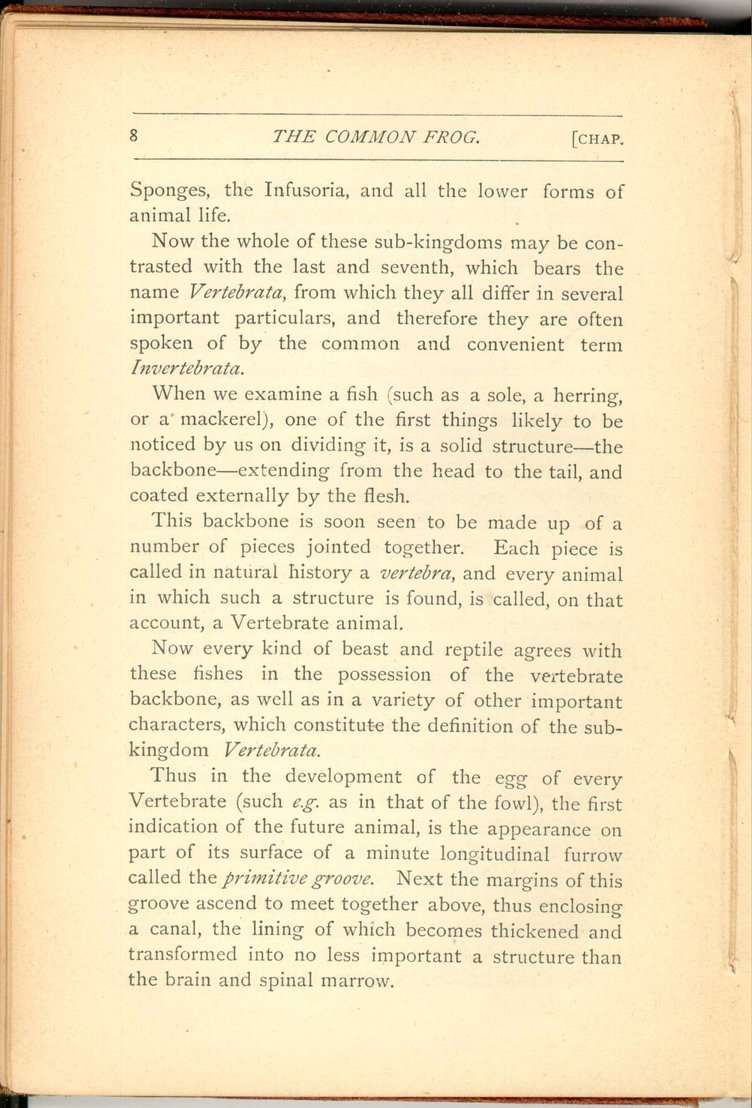 [Description:
Image of page 8.
]
[Description:
Image of page 8.
]
Now the whole of these sub-kingdoms may be contrasted with the last and seventh, which bears the name Vertebrata, from which they all differ in several important particulars, and therefore they are often spoken of by the common and convenient term Invertebrata.
When we examine a fish (such as a sole, a herring, or a mackerel), one of the first things likely to be noticed by us on dividing it, is a solid structure—the backbone—extending from the head to the tail, and coated externally by the flesh.
This backbone is soon seen to be made up of a number of pieces jointed together. Each piece is called in natural history a vertebra, and every animal in which such a structure is found, is called, on that account, a Vertebrate animal.
Now every kind of beast and reptile agrees with these fishes in the possession of the vertebrate backbone, as well as in a variety of other important characters, which constitute the definition of the sub kingdom Vertebrata.
Thus in the development of the egg of every Vertebrate (such e.g. as in that of the fowl), the first indication of the future animal, is the appearance on part of its surface of a minute longitudinal furrow called the primitive groove. Next the margins of this groove ascend to meet together above, thus enclosing a canal, the lining of which becomes thickened and transformed into no less important a structure than the brain and spinal marrow.
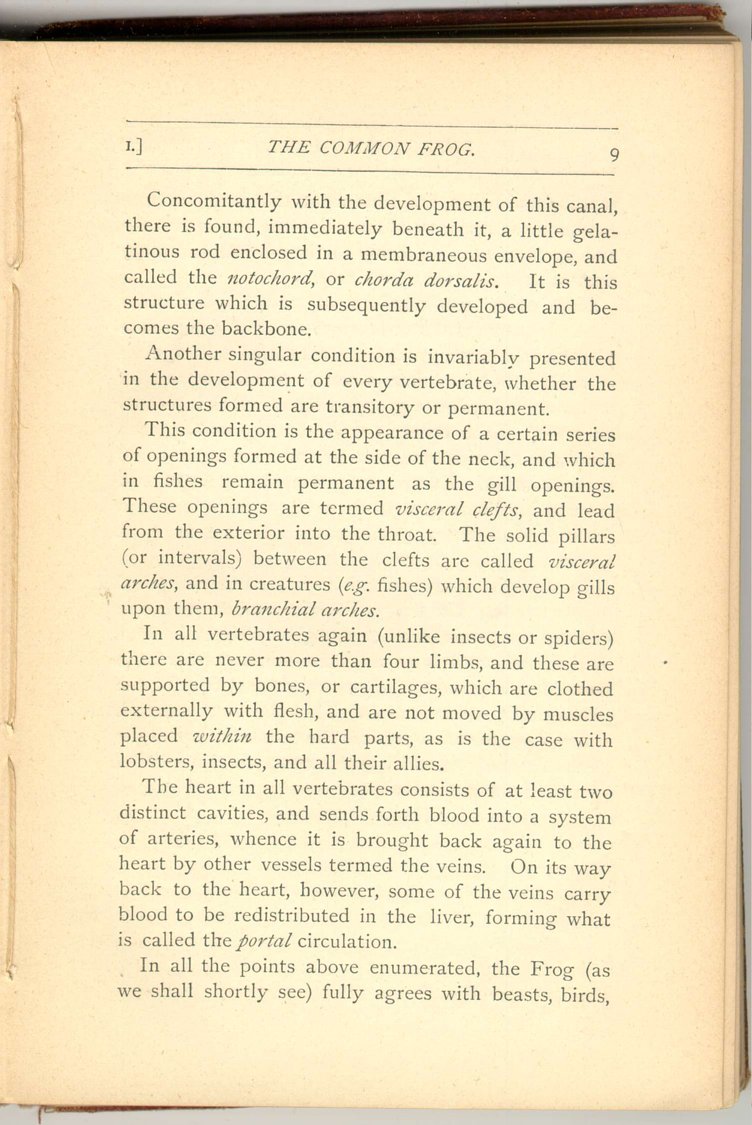 [Description:
Image of page 9.
]
[Description:
Image of page 9.
]
Concomitantly with the development of this canal, there is found, immediately beneath it, a little gelatinous rod enclosed in a membraneous envelope, and called the notochord, or chorda dorsalis. It is this structure which is subsequently developed and becomes the backbone.
Another singular condition is invariably presented in the development of every vertebrate, whether the structures formed are transitory or permanent.
This condition is the appearance of a certain series of openings formed at the side of the neck, and which in fishes remain permanent as the gill openings. These openings are termed visceral clefts, and lead from the exterior into the throat. The solid pillars (or intervals) between the clefts are called visceral arches, and in creatures (e.g. fishes) which develop gills upon them, branchial arches.
In all vertebrates again (unlike insects or spiders) there are never more than four limbs, and these are supported by bones, or cartilages, which are clothed externally with flesh, and are not moved by muscles placed within the hard parts, as is the case with lobsters, insects, and all their allies.
The heart in all vertebrates consists of at least two distinct cavities, and sends forth blood into a system of arteries, whence it is brought back again to the heart by other vessels termed the veins. On its way back to the heart, however, some of the veins carry blood to be redistributed in the liver, forming what is called the portal circulation.
In all the points above enumerated, the Frog (as we shall shortly see) fully agrees with beasts, birds,
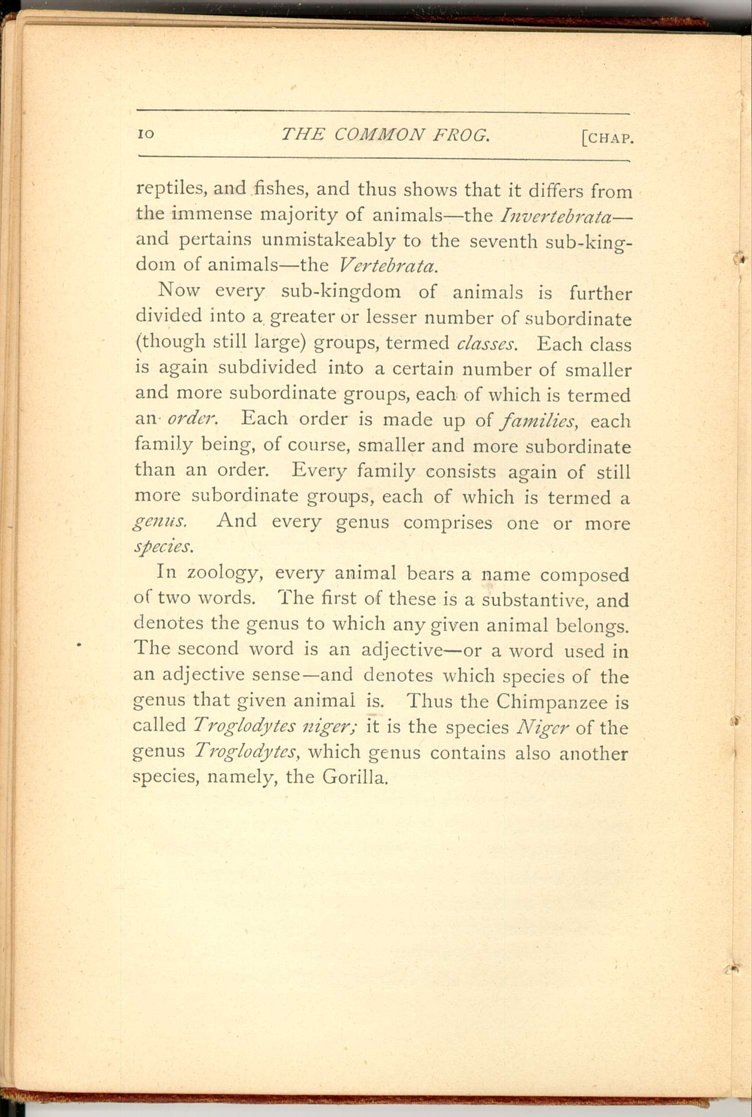 [Description:
Image of page 10.
]
[Description:
Image of page 10.
]
Now every sub-kingdom of animals is further divided into a greater or lesser number of subordinate (though still large) groups, termed classes. Each class is again subdivided into a certain number of smaller and more subordinate groups, each of which is termed an order. Each order is made up of families, each family being, of course, smaller and more subordinate than an order. Every family consists again of still more subordinate groups, each of which is termed a genus. And every genus comprises one or more species.
In zoology, every animal bears a name composed of two words. The first of these is a substantive, and denotes the genus to which any given animal belongs. The second word is an adjective—or a word used in an adjective sense—and denotes which species of the genus that given animal is. Thus the Chimpanzee is called Troglodytes niger; it is the species Niger of the genus Troglodytes which genus contains also another species, namely, the Gorilla.
FOOTNOTES: Chapter 1
Analogous relationship refers to the uses to which parts are put. Relationship of affinity refers either to such a relationship as that of kindred or to an ideal affinity reposing on similarities of structure.
|
THE COMMON FROG
CHAPTER I.
The Common Frog | ||